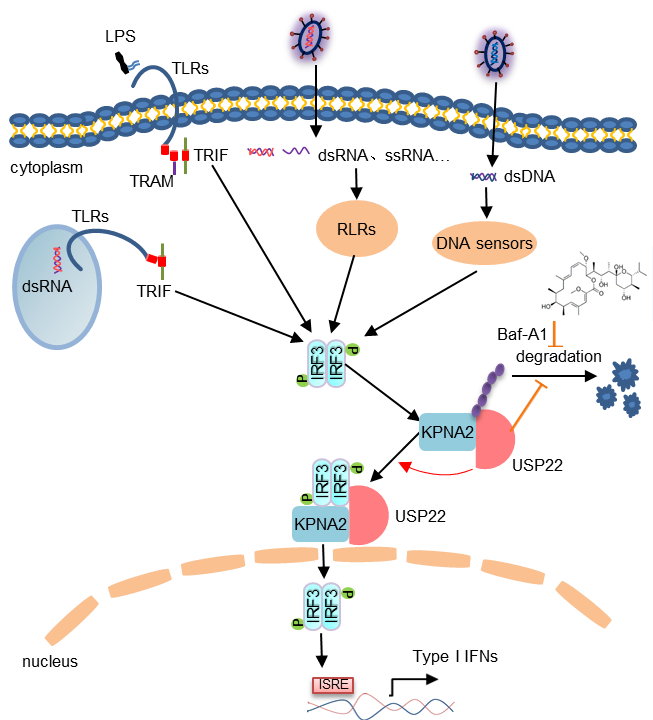Dr. Bo Zhong’s group published an article entitled "USP22 promotes IRF3 nuclear translocation and antiviral responses by deubiquitinating the importin protein KPNA2" on The Journal of Experimental Medicine
On March 4th, Dr. Bo Zhong’s group published an article entitled "USP22 promotes IRF3 nuclear translocation and antiviral responses by deubiquitinating the importin protein KPNA2" on The Journal of Experimental Medicine (https://doi.org/10.1084/jem.20191174). In this study, they identified USP22 as a deubiquitinating enzyme for the importin protein KPNA2 to promote nuclear translocation of IRF3 after viral infection.
Type I IFNs are important cytokines to protect the body from viral infection, and IRF3 is a critical transcription factor or virus-triggered expression of type I IFNs. The activation of IRF3 involves multiple steps including phosphorylation, dimerization and nuclear translocation. Available studies have clearly shown how IRF3 is phosphorylated and undergoes dimerization after viral infection. However, the mechanism of nuclear translocation of IRF3 is less clear. In this study, the authors have found that the viral infection-induced nuclear translocation of IRF3 relies on the assistance of the nuclear transport protein family member KPNA2, while USP22 promotes the nuclear translocation of IRF3 by deubiquitinating and stabilizing KPNA2. This in turn promotes the expression of type I IFNs andcellular antiviral responses.Knockout of USP22 significantly potentiates viral infection-induced the ubiquitin modification and autophagy-dependent degradation of KPNA2, and impairs the expression of downstream genes such as type I IFNs. USP22 conditional knockout mice are more susceptible to viruses such as VSV and HSV-1 than the control littermates and produce decreased level of type I IFNs in the sera compared to the control littermates.
The research is supported by projects such as the National Key Research and Development Program, the National Natural Science Foundation of China's Outstanding Youth Science Fund and Key Projects, the Hubei Natural Science Foundation, and the Wuhan University Medical Ascendas Program and Independent Research Projects. The corresponding author is Dr. Bo Zhong who is a professor at Medical Research Institute, Frontier Science Center for Immunology and Metabolism, and at College of Life Sciences, Wuhan University. The first author is Mr. Zeng Cai, who is a fifth-year grade Ph.D. student at College of Life Sciences, Wuhan University.
